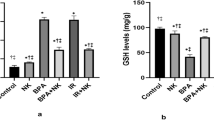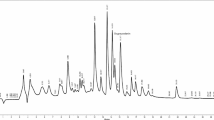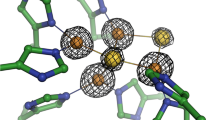Abstract
Acute and chronic administration of Al-gluconate (12.7% Al) at the concentration of 1 mg/kg produces edema in the rat brain, as reflected by the increase in water and Na+ content. The permeability for Evans blue is also increased, which indicates the opening of the blood-brain barrier. Higher concentrations of the Al-gluconate (10 mg/kg) change, in acute experiments, the pattern of energy metabolites in the rat brain toward a profile observed in a deep hypoxia. Chronic administration of a low concentration of Al-gluconate (1 mg/kg) increases the local utilization of glucose in 20 of 39 rat brain structures examined. This increase was particularly evident in the structures of the limbic system. Xanthine derivative propentofylline reverses the edema formation in acute and chronic experiments. Hypoxialike changes in energy metabolism are also reversed by propentofylline. In preliminary experiments propentofylline also suppressed the increased utilization of glucose observed after administration of Al-gluconate. These results suggest that (i) the Al-gluconate model in rats can be used to study Al-neurotoxicity at a very low level of Al, and (ii) the xanthine derivative propentofylline can eventually be used to abolish the Al-neurotoxicity.
Similar content being viewed by others
References
Alfrey, A. C., LeGendre, G. R., and Kaehny, W. D. (1976). The dialysis encepalopathy syndrome. Possible aluminum intoxication.N. Engl. J. Med. 294: 184–188.
Perl, D., Gajdusek, D., and Garruto, R. (1982). Intraneuronal aluminium accumulation in amyotrophic lateral sclerosis and Guam parkinsonism-dementia of Guam.Science 217: 1053–1055.
Crapper McLachlan, D. R. (1986). Aluminum and Alzheimer's disease.Neurobiol. Aging 7: 525–532.
Wisniewski, H. M., Moretz, R. C., and Iqbal, K. (1986). No evidence for aluminum in ethiology and pathogenesis of Alzheimer's disease.Neurobiol. Aging 7: 532–535.
Perl, D. P., and Brody, A. R. (1980). Alzheimer disease: X-ray spectrometric evidence of aluminum accumulation in neurofibrillary tangles bearing neurons.Science 208: 297–299.
Candy, J. M., Klinowski, R. H., Perry. H.,et al. (1986). Aluminosilicates and senile plaque formation in Alzeheimer's disease.Lancet 1: 354–356.
Rössner, W., and Tempel, K. (1966). Quantitative Bestimmung der Permeabilität der sogenannten Blut-Hirnschranke für Evans-Blau (T1824.Med. Pharmacol. Exp. 14: 169–182.
Sztriha, L., Joó, F., and Szerdahelyi, P. (1986). Time-course of changes in water, sodium, potassium and calcium contents of various brain regions in rats after systemic kainic acid administration.Acta Neuropathol. 70: 169–176.
Temesvári, P., Joó, F., Koltai, M., Eck, E., Ádám, G., Siklós, L., and Boda, D. (1984). Cerebroprotective effect of dexamethasone by increasing the tolerance to hypoxia and preventing brain oedema in newborn piglets with experimental pneumothorax.Neurosci. Lett. 49: 87–92.
McMillan, V., and Siesjö, B. K. (1972). Brain energy metabolism in hypoxemia.Scand. J. Clin. Lab. Invest. 30: 127–136.
Atkinson, D. E. (1968). The energy charge of the adenylate pool as regulatory parameter. Interaction with feedback modifiers.Biochemistry 7: 4030–4034.
Sokoloff, L., Revich, M., Kennedy, C., Des Rosiers, M. H., Patlak, C. S., Pettigrew, K. D., Sakurada, O., and Shirohara, M. (1977). The deoxyglucose method for the measurement of local cerebral glucose utilization: Theory, procedure and normal values in the conscious and anaesthetised albino rat.J. Neurochem. 28: 897–916.
Miller, R. G. (1966).Simultaneous Statistical Interference, MacGraw-Hill, New York.
Banks, W. A., and Kastin, A. J. (1983). Aluminum increases permeability of the blood-brain barrier to labelled DSIP and β-endorphin: Possible implications for senile and dialysis dementia.Lancet 2: 1227–1229.
Kim, Y. S., Lee, H. M., and Wisniewski, H. M. (1986). Aluminum induced reversible change in permeability of the blood-brain barrier to (14C) sucrose.Brain Res. 377: 286–291.
Klatzo, I. (1967). Neuropathological aspects of brain edema.J. Neuropathol. Exp. Neurol. 26: 1–14.
Leblondel, G., and Allain, P. (1980). Blood and brain aluminum in mice afer intra-peritoneal injection of different aluminum compounds.Res. Comm. Chem. Path. Pharmacol. 27: 579–586.
Stefanovich, V. (1981). Anoxic rat model. In Stefanovich, V. (ed.),Proceedings of the Symposium Animal Models and Hypoxia, Pergamon Press, Oxford, pp. 111–123.
Grome, J. J., and Stefanovich, V. (1986). Differential effects of xanthine derivatives on local cerebral blood flow and glucose utilization in the conscious rat. In Stefanovich, V., Rudolphi, K., and Schubert, P. (eds.),Adenosine: Receptors and Modulation of Cell Functions, IRL Press, Oxford, pp. 453–457.
Nagy, Z., Peters, H., and Huttner, I. (1981). Endothelial surface charge: Blood-brain barrier opening to horseradish peroxidase induced by the polycation protamine sulfate.Acta Neuropathol. Supl. VII: 7–9.
Mrsulja, B. B., Mićić, D. V., and Stefanovich, V. (1985). Propentofylline and postischemic brain edema: Relationship to Na+, K+-ATPase activity.Drug Dev. Res. 6: 339–344.
Sokoloff, L. (1979). Mapping of local cerebral functional activity by measurement of local cerebral glucose utilization with (14C)-deoxyglucose.Brain 102: 653–668.
Foncin, J. F., and El Hachimi, K. H. (1986). Neurofibrillary degeneration in Alzheimer's disease: A discussion with a contribution to aluminum pathology in man. In Bès, A.,et al. (eds.),Senile Dementias: Early Detection, John Libbey Eurotext, pp. 191–201.
Fredholm, B. B., and Lindstrom, K. (1986). The xanthine derivative 1-(5′-oxohexyl)-3-methyl-7-propyl-xanthine (HWA 285) enhances the action of adenosine.Acta Pharmacol. Toxicol. 58: 187–192.
Vukadinović, V., Stefanovich, V., and Rakić, L. (1986). Effect of propentofylline on a GABA system of a rat brain.Drug Dev. Res. 7: 87–94.
Author information
Authors and Affiliations
Rights and permissions
About this article
Cite this article
Stefanovich, V., Joó, F. Effect of propentofylline on the biochemical lesion of the rat brain in aluminium-induced neurotoxicity. Metab Brain Dis 5, 7–17 (1990). https://doi.org/10.1007/BF00996974
Received:
Accepted:
Issue Date:
DOI: https://doi.org/10.1007/BF00996974




